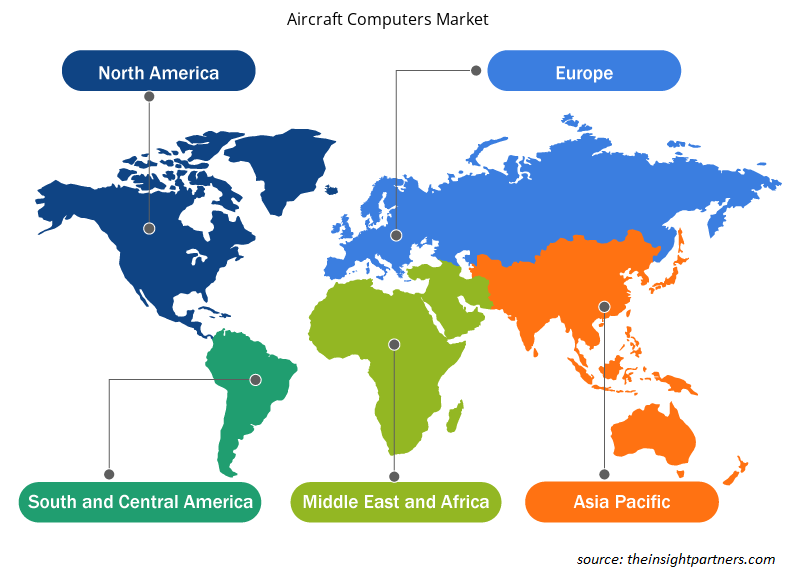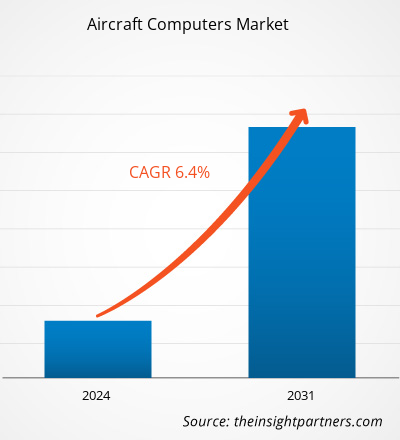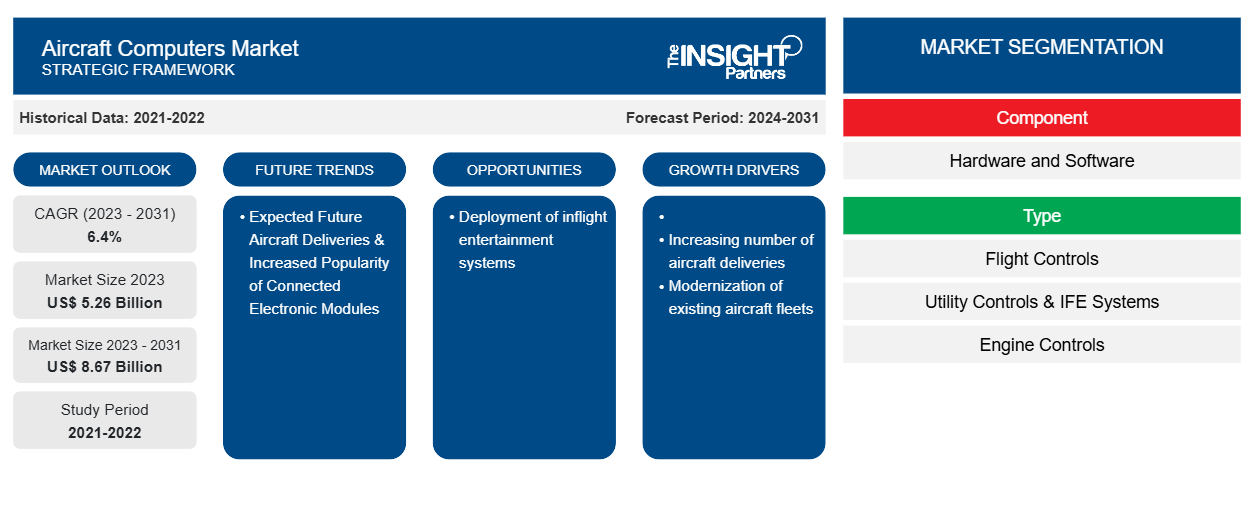Der Markt für Bordcomputer soll von 5,26 Milliarden US-Dollar im Jahr 2023 auf 8,67 Milliarden US-Dollar im Jahr 2031 anwachsen. Der Markt dürfte zwischen 2023 und 2031 eine durchschnittliche jährliche Wachstumsrate von 6,4 % verzeichnen. Der Einsatz von Bordunterhaltungssystemen dürfte ein wichtiger Trend auf dem Markt bleiben.
Marktanalyse für Flugzeugcomputer
Das Ökosystem des Marktes für Flugzeugcomputer entwickelt sich weiter. Seine Interessenvertreter sind Komponentenlieferanten, Hersteller von Flugzeugcomputern und Endnutzer. Wichtige Akteure besetzen Plätze im zweiten Knoten des Marktökosystems. Komponentenhersteller liefern verschiedene Komponenten wie Aktuatoren, Sensoren und Steuerungssysteme an verschiedene Produkthersteller, die diese zur Herstellung des endgültigen Flugzeugcomputerprodukts verwenden, das dann an Flugzeughersteller, MRO-Anbieter, kommerzielle Fluggesellschaften, Streitkräfte und Besitzer von Geschäftsflugzeugen oder Hubschraubern geliefert wird. Unternehmen wie BAE Systems Plc, Garmin Ltd., General Electric, General Dynamics Mission Systems, Honeywell International Inc., Lockheed Martin Corporation, Raytheon Technologies Corporation, SAAB AB, Safran und Thales Group gehören zu den führenden Herstellern auf dem Markt für Flugzeugcomputer. Diese Unternehmen bieten Endnutzern wie Flugzeugherstellern, kommerziellen Fluggesellschaften, Streitkräften und Eigentümern der allgemeinen Luftfahrt bzw. anderen Kunden ein breites Spektrum an Dienstleistungen im Bereich Flugzeugcomputer an.
Marktübersicht für Flugzeugcomputer
Das Wachstum des Marktes für Flugzeugcomputer in Nordamerika ist auf die Präsenz einer großen Anzahl von Flugzeugherstellern zurückzuführen, wie etwa Boeing, Airbus, Lockheed Martin Corporation, Raytheon Technologies Corporation, General Dynamics Mission Systems, Inc. und Northrop Grumman Corporation. Die wachsende Zahl an bevorstehenden Flugzeuglieferungen sowie die Präsenz einer großen Anzahl von Flugzeuganbietern dürften das Wachstum des Marktes für Flugzeugcomputer in Nordamerika in den kommenden Jahren begünstigen. Die steigende Nachfrage nach Flugzeugcomputern in unbemannten Luftfahrzeugen (UAVs) ist ein weiterer Faktor, der das Marktwachstum in dieser Region unterstützt.
Passen Sie diesen Bericht Ihren Anforderungen an
Sie erhalten kostenlos individuelle Anpassungen an jedem Bericht, einschließlich Teilen dieses Berichts oder einer Analyse auf Länderebene, eines Excel-Datenpakets sowie tolle Angebote und Rabatte für Start-ups und Universitäten.
-
Holen Sie sich die wichtigsten Markttrends aus diesem Bericht.Dieses KOSTENLOSE Beispiel umfasst eine Datenanalyse von Markttrends bis hin zu Schätzungen und Prognosen.
Treiber und Chancen auf dem Flugzeugcomputermarkt
Modernisierung bestehender Flugzeugflotten
Die Modernisierung bestehender Flotten trägt dazu bei, ihre Nachhaltigkeit zu verbessern, indem sie den Treibstoffverbrauch und die CO2-Emissionen reduziert und so die Flugleistung verbessert. Die Entwicklung fortschrittlicher elektronischer Systeme und Computer macht es erforderlich, die älteren elektronischen Systeme in den derzeit verwendeten Flugzeugmodellen zu ersetzen. Mehrere Länder legen Wert auf die Entwicklung und Beschaffung von Flugzeugflotten der nächsten Generation , um ihre Flotten zu modernisieren und zu erweitern, was die Nachfrage nach fortschrittlichen Flugzeugcomputersystemen fördert. So modernisierte die Lufthansa Group im Mai 2021 ihre Flotte und kaufte 10 hocheffiziente Langstreckenflugzeuge mit dem Ziel, die Effizienz zu verbessern und die Betriebskosten zu senken. Darüber hinaus erhielt die französische Verteidigungsbeschaffungsagentur im Januar 2022 das sechste ATL2-Seeaufklärungsflugzeug, das von Standard 5 auf Standard 6 aufgerüstet wurde. Ziel der oben genannten Modernisierungsinitiative war es, neue Technologien zu entwickeln und sie in taktische Missionssysteme, Sensorsubsysteme und Anzeigekonsolen bestehender Flugzeuge zu integrieren, gefolgt von der Wiederherstellung der Flugzeugleistung auf Spitzenniveau. Durch die Modernisierung dieser fortschrittlichen Systeme entsteht ein Bedarf an technologisch tragfähigen Computersystemen für Flugzeuge, der das Marktwachstum im Prognosezeitraum vorantreibt.
Erwartete zukünftige Flugzeugauslieferungen und Popularität vernetzter elektronischer Module
Boeing hat rund 300 Bestellungen für die neue Generation der 777-Familie erhalten und im April 2022 die Auslieferung seines ersten 777X-Flugzeugs auf 2025 verschoben. Im Mai 2021 plante Airbus eine durchschnittliche Produktionsrate der A320-Familie von 45 Flugzeugen pro Monat und wollte diese Produktionsrate bis zum vierten Quartal 2021 erreichen. Darüber hinaus dürfte die Produktionsrate bis zum zweiten Quartal 2023 auf 64 Flugzeuge pro Monat, bis zum ersten Quartal 2024 auf 70 Flugzeuge pro Monat und bis 2024 auf 75 Flugzeuge pro Monat gesteigert werden. Im Mai 2022 bestätigte Qantas seine Bestellung von 12 Airbus A350-1000 für seine Ultralangstrecken-Initiative Project Sunrise. Darüber hinaus rechnet Boeing laut dem von Boeing veröffentlichten Commercial Market Outlook 2021–2040 damit, in den nächsten 20 Jahren insgesamt 43.610 Flugzeuge auszuliefern, darunter 2.390 Regionaljets, 32.660 Schmalrumpfflugzeuge, 7.670 Großraumflugzeuge und 890 Frachtflugzeuge. Daher dürfte die Pipeline der Flugzeugauslieferungen im Prognosezeitraum potenzielle Wachstumschancen für die Akteure auf dem Markt für Flugzeugcomputer bieten. Solche Faktoren dürften die Nachfrage nach Flugzeugcomputern in den kommenden Jahren ankurbeln.
Segmentierungsanalyse des Marktberichts für Flugzeugcomputer
Wichtige Segmente, die zur Ableitung der Marktanalyse für Flugzeugcomputer beigetragen haben, sind Komponente, Typ, Plattform und Passform.
- Basierend auf den Komponenten ist der Markt für Flugzeugcomputer in Hardware und Software unterteilt. Das Hardwaresegment hatte im Jahr 2023 einen größeren Marktanteil.
- Basierend auf dem Typ ist der Markt für Flugzeugcomputer in Flugsteuerungen, Versorgungssteuerungen und Bordsysteme, Triebwerkssteuerungen, Missionscomputer und Flugmanagementcomputer unterteilt. Das Segment Flugsteuerung hatte im Jahr 2023 einen größeren Marktanteil.
- Nach Plattform ist der Markt in Starrflügelflugzeuge, Drehflügler und unbemannte Luftfahrzeuge segmentiert. Das Segment der Starrflügelflugzeuge hatte im Jahr 2023 den größten Marktanteil.
- Nach Einbauart ist der Markt in Line-Fit und Retrofit segmentiert. Das Line-Fit-Segment hatte im Jahr 2023 den größten Marktanteil.
Marktanteilsanalyse für Flugzeugcomputer nach Geografie
Der geografische Umfang des Marktberichts für Flugzeugcomputer ist hauptsächlich in fünf Regionen unterteilt: Nordamerika, Europa, Asien-Pazifik, Naher Osten und Afrika sowie Südamerika.
Nordamerika dominierte den Markt im Jahr 2023, gefolgt von Europa und dem asiatisch-pazifischen Raum. Darüber hinaus dürfte der asiatisch-pazifische Raum in den kommenden Jahren der dominierende Markt für Flugzeugcomputer werden. Der asiatisch-pazifische Raum hat seit den letzten Jahren aufgrund der Zunahme internationaler Reisender aus aller Welt in Ländern wie Indien, China, Japan und Taiwan einen starken Import moderner Verkehrsflugzeuge verzeichnet. Aufgrund der zunehmenden Zahl von Flugzeugen und Flughäfen wird die Nachfrage nach MRO-Diensten für Flugzeuge im Prognosezeitraum stark ansteigen. Es wird erwartet, dass die Region etwa 40 % der zukünftigen Fluglinienproduktion ausmacht, um die Nachfrage nach Flugzeugen zu decken. Die zunehmende Zahl von Flughäfen und der steigende regionale Flugverkehr zwischen asiatischen Ländern fördern die Nachfrage nach Flugzeugcomputern und -systemen für einen sichereren Betrieb. Um diesen Bedarf zu decken, entwickeln neue und bestehende Akteure neue Systeme, was wiederum das Marktwachstum im asiatisch-pazifischen Raum in den kommenden Jahren vorantreiben dürfte.MRO services will soar during the forecast period. The region is expected to account for ~40% of the future airline production to suffice the aircraft demand. The increasing number of airports and rising regional flight transportation between Asian countries are encouraging the demand for aircraft computers and systems to perform safer operations. To fulfill these needs, new and existing players are developing new systems, which, in turn, is expected to drive the market growth across the Asia Pacific region in the coming years.
Regionale Einblicke in den Markt für Flugzeugcomputer
Die regionalen Trends und Faktoren, die den Markt für Flugzeugcomputer im Prognosezeitraum beeinflussen, wurden von den Analysten von Insight Partners ausführlich erläutert. In diesem Abschnitt werden auch die Marktsegmente und die Geografie für Flugzeugcomputer in Nordamerika, Europa, im asiatisch-pazifischen Raum, im Nahen Osten und Afrika sowie in Süd- und Mittelamerika erörtert.

- Holen Sie sich die regionalen Daten für den Flugzeugcomputermarkt
Umfang des Marktberichts zu Flugzeugcomputern
| Berichtsattribut | Details |
|---|---|
| Marktgröße im Jahr 2023 | 5,26 Milliarden US-Dollar |
| Marktgröße bis 2031 | 8,67 Milliarden US-Dollar |
| Globale CAGR (2023 - 2031) | 6,4 % |
| Historische Daten | 2021-2022 |
| Prognosezeitraum | 2024–2031 |
| Abgedeckte Segmente |
Nach Komponente
|
| Abgedeckte Regionen und Länder |
Nordamerika
|
| Marktführer und wichtige Unternehmensprofile |
|
Marktteilnehmerdichte für Flugzeugcomputer: Auswirkungen auf die Geschäftsdynamik verstehen
Der Markt für Flugzeugcomputer wächst rasant, angetrieben durch die steigende Nachfrage der Endnutzer aufgrund von Faktoren wie sich entwickelnden Verbraucherpräferenzen, technologischen Fortschritten und einem größeren Bewusstsein für die Vorteile des Produkts. Mit steigender Nachfrage erweitern Unternehmen ihr Angebot, entwickeln Innovationen, um die Bedürfnisse der Verbraucher zu erfüllen, und nutzen neue Trends, was das Marktwachstum weiter ankurbelt.
Die Marktteilnehmerdichte bezieht sich auf die Verteilung von Firmen oder Unternehmen, die in einem bestimmten Markt oder einer bestimmten Branche tätig sind. Sie gibt an, wie viele Wettbewerber (Marktteilnehmer) in einem bestimmten Marktraum im Verhältnis zu seiner Größe oder seinem gesamten Marktwert präsent sind.
Die wichtigsten auf dem Markt für Flugzeugcomputer tätigen Unternehmen sind:
- AAR CORP
- AeroRepair Corp.
- AEROSPACE MRO CO., LTD.
- Air Atlanta Flugdienste
- AMETEK Inc.
Haftungsausschluss : Die oben aufgeführten Unternehmen sind nicht in einer bestimmten Reihenfolge aufgeführt.

- Überblick über die wichtigsten Akteure auf dem Markt für Flugzeugcomputer
Neuigkeiten und aktuelle Entwicklungen zum Flugzeugcomputermarkt
Der Markt für Flugzeugcomputer wird durch die Erhebung qualitativer und quantitativer Daten nach Primär- und Sekundärforschung bewertet, die wichtige Unternehmensveröffentlichungen, Verbandsdaten und Datenbanken umfasst. Nachfolgend sind einige der Entwicklungen auf dem Markt für Flugzeugcomputer aufgeführt:
Universal Avionics (UA), ein Unternehmen von Elbit Systems, hat die ersten Flugtests seines softwarebasierten interaktiven Flugmanagementsystems (i-FMS) NexGen erfolgreich abgeschlossen. Die Flugtests wurden in Österreich mit einem Bell 212-Hubschrauber der Regierung durchgeführt. Dies geschah im Rahmen einer gemeinsamen Anstrengung mit Elbit, um die Flugmanagement- und Navigationsfunktionen für den Kunden zu verbessern. (Quelle: Universal Avionics, Pressemitteilung, Dezember 2023)
- CMC Electronics gab heute einen mehrjährigen Vertrag mit der in der Schweiz ansässigen Pilatus Aircraft Ltd. über den Kauf seiner hochmodernen Avioniklösungen für den PC-21 Next Generation Trainer bekannt. (Quelle: CMC Electronics, Pressemitteilung, August 2023)
Marktbericht zu Flugzeugcomputern – Umfang und Ergebnisse
Der Bericht „Marktgröße und Prognose für Flugzeugcomputer (2021–2031)“ bietet eine detaillierte Analyse des Marktes, die die folgenden Bereiche abdeckt:
- Marktgröße und Prognose für Flugzeugcomputer auf globaler, regionaler und Länderebene für alle wichtigen Marktsegmente, die im Rahmen des Berichts abgedeckt sind
- Markttrends für Flugzeugcomputer sowie Marktdynamik wie Treiber, Einschränkungen und wichtige Chancen
- Detaillierte Porter-Fünf-Kräfte-Analyse
- Marktanalyse für Flugzeugcomputer mit Blick auf wichtige Markttrends, globale und regionale Rahmenbedingungen, wichtige Akteure, Vorschriften und aktuelle Marktentwicklungen
- Branchenlandschaft und Wettbewerbsanalyse, einschließlich Marktkonzentration, Heatmap-Analyse, prominenten Akteuren und aktuellen Entwicklungen auf dem Markt für Flugzeugcomputer
- Detaillierte Firmenprofile
- Historische Analyse (2 Jahre), Basisjahr, Prognose (7 Jahre) mit CAGR
- PEST- und SWOT-Analyse
- Marktgröße Wert/Volumen – Global, Regional, Land
- Branchen- und Wettbewerbslandschaft
- Excel-Datensatz
Aktuelle Berichte
Erfahrungsberichte
Grund zum Kauf
- Fundierte Entscheidungsfindung
- Marktdynamik verstehen
- Wettbewerbsanalyse
- Kundeneinblicke
- Marktprognosen
- Risikominimierung
- Strategische Planung
- Investitionsbegründung
- Identifizierung neuer Märkte
- Verbesserung von Marketingstrategien
- Steigerung der Betriebseffizienz
- Anpassung an regulatorische Trends























 Kostenlose Probe anfordern für - Markt für Flugzeugcomputer
Kostenlose Probe anfordern für - Markt für Flugzeugcomputer